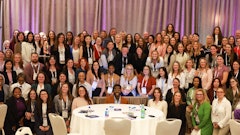
Career and technical education (CTE) is a cornerstone of modern K-12 education, giving students the hands-on skills they need to thrive in an ever-changing workforce. With rapid technological shifts like automation, AI, and advanced manufacturing reshaping industries, it’s clear that students, more than ever, need to be equipped with robust, career-focused learning.
In today’s America, the stakes are high: more than 40% of U.S. employers are already struggling to find workers who have the skills necessary to fill even entry-level jobs. This skills gap threatens to cost the economy $1.2 trillion over the next decade.
But there is a solution to helping novice workers and corporations fill these gaps and improve their odds of succeeding amidst economic uncertainty: offering career training as early as high school.
NAF offers more than 600 career readiness academies for more than 112,000 high school students nationwide. For NAF, it’s all about connecting students with local business leaders and giving them a head start on career training. Thanks to these school-business partnerships, today’s high school students are getting hands-on experience, mentorships, internships, apprenticeships, and networking opportunities with local businesses long before they get their diploma.
But how, exactly, does career training early on help them succeed in an uncertain workforce?
Students learn both technical and durable skills. A survey of NAF students found that nearly 80% indicated that work-based learning experiences helped them identify and build career skills.
Students build confidence in their abilities. When students have a chance to apply and build their skills in a work environment and take charge of projects, they're better able to navigate what comes next. These experiences help build confidence in their abilities and knowledge and show them the value they are capable of adding to the workplace.
They build relationships with mentors and industry professionals. Students get a chance to meet with industry professionals and build a network and their own social capital. Engaging with industry professionals is key for students trying to figure out what they want — and don’t want — from a future career. Plus, students can get direct advice, a blueprint of sorts, on the steps they need to take to get a job in certain career pathways.
They're better prepared for college and career success. Nearly 90% of NAF's students are college-bound and 65% join the workforce or military not long after they graduate. More than 70% of students surveyed felt that their experiences with work-based learning better helped them understand what they wanted to do for a living.
Some students don’t go straight to college. Of course, not all U.S. students are headed to college. Many of them take gap years to intern and secure jobs before considering their next move. During this time, students can benefit from networking and asking professionals questions about their career journeys. Hospitality, engineering, health sciences, finance, and information technology are valuable industries for students to explore during a gap year. The relationships they build during this time can help them secure a job; as most jobs come from connection.
There’s never been a better time for educators to seize the opportunity to prioritize career-focused learning in America’s schools. While a student’s future is theirs to create, today’s educators need to provide more youth with real-world job skills, while exposing them to a full continuum of work-based learning experiences (job shadows, worksite tours, apprenticeships, internships, etc.). These resources will help students learn what they like — and don’t like — about certain career paths, make informed career choices, and build their social capital to gain economic mobility.
High school is the time for the next wave of workforce talent to make crucial decisions about their futures, making it all the more essential for them to become familiar with the world of work before landing on their choices. Whether it’s encouraging school districts to form partnerships with work-based learning focused organizations or offering CTE lessons and activities in the classroom, the supply chain industry can embrace new opportunities, continue to champion access and readiness, and shape a brighter future for the next generation.


![Pros To Know 2026 [color]](https://img.sdcexec.com/mindful/acbm/workspaces/default/uploads/2025/08/prostoknow-2026-color.mduFvhpgMk.png?auto=format%2Ccompress&bg=fff&fill-color=fff&fit=fill&h=100&q=70&w=100)







![Pros To Know 2026 [color]](https://img.sdcexec.com/mindful/acbm/workspaces/default/uploads/2025/08/prostoknow-2026-color.mduFvhpgMk.png?ar=16%3A9&auto=format%2Ccompress&bg=fff&fill-color=fff&fit=fill&h=135&q=70&w=240)





